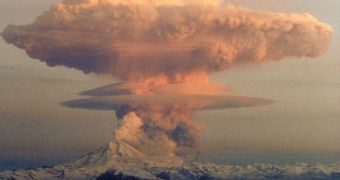After numerous warnings, in the form of tremors and increased pressure in its magma chamber, Mount Redoubt in Alaska erupted four times last night, sending plumes of ash and gases more than 9 miles high into the atmosphere. The events took place between 10:38 pm on Sunday evening and 1:39 am on Monday morning, local time, but the clouds of ash drifted towards North and Northeast, away from the largest human settlements in the area.
Alaska Volcano Observatory geologist Janet Schaefer says that the first eruption occurred in the Cook Inlet, the Kenai Peninsula, and that the winds are continuing to blow in a favorable direction, sending most of the ash away from the city of Anchorage. People should not celebrate just yet, geophysicist John Power adds, as it's still early to predict where most of the ash will go. Thus far, none of the larger cities in the area has reported any fallout following the eruption.
National Weather Service hydrometeorogical technician Dave Stricklan expects that only fine ash will fall on Alaskan cities. “Just kind of a light dusting. The heavier stuff drops out very quickly, and then the other stuff filters out. There's going to be a very fine amount of it that's going to be suspended in the atmosphere for quite some time, but nothing to really affect anything such as aviation travel. The heavier stuff will filter out,” the expert points out.
The main problem with this very fine powder is that it can easily enter the nostrils of humans and animals, and can deposit itself in the lungs, creating serious pulmonary conditions. When the small dust begins to drop on cities, experts advise, people should avoid getting out of the house needlessly, and should wait for authorities to neutralize the fine dust with water or other liquids. If it is swept away, there's a good chance that it will become airborne again, which would make the efforts futile.
Since late January, experts working at the Observatory cautioned that the mountain could erupt at any time, and remained on high alert until Sunday. Between 40 and 50 tremors were recorded each hour throughout the previous day, and a plume of Steam reaching about a mile in length could be observed coming out of the mountaintop since Saturday. This made the experts raise the alert level around the mountain to critical in the hours preceding the eruptions.

 14 DAY TRIAL //
14 DAY TRIAL //